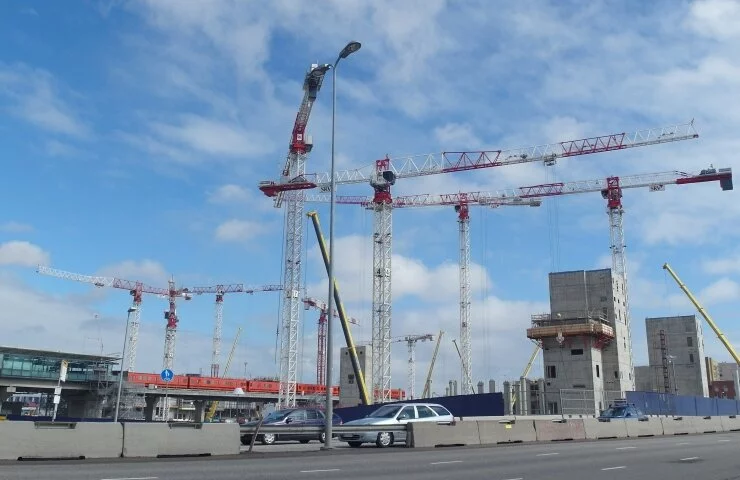Don’t even try to keep up with the dizzying speed at which Helsinki is transforming itself. Love or hate the seismic shift in identity and appearance, it is undeniable that wherever you go, the Finnish capital is getting a fundamental facelift.
Adhering to the old adage that change is always fashionably late, it often takes the powers that be frustratingly long to reach a consensus on how the future challenges of a city should be met. True to all bureacracy, they are known to spend hours, weeks, months or even years debating everything from how many floors a skyscraper should have, how much to invest on a bridge, when – if at all – an abandoned house can be turned into something functional, and which colour to paint a blockful of houses.
Still, entirely new districts keep popping up everywhere, new buildings are sprinkled on previously empty spaces, and skyscrapers are erected to reshape the skyline of the city. In case you’ve been living under a rock, or haven’t been to Helsinki for some time, here’s where you should go for a glimpse into the future:
1 Kalasatama
Construction has become a staple of Kalasatama. (Photo by Samuli Launonen).
Nowhere is Helsinki’s transformation more tangible than in the district of Kalasatama (Fish Harbour). The former wasteland is morphing into a brand new residential and commercial neighborhood with swanky skyscrapers – the first of their kind in central Helsinki and virtually unheard of elsewhere in Finland – and households utilising solar and wind power.
The construction work has been underway for a few years and the first families have now moved to homes still fresh from paint.
When I lived in East Helsinki, I passed the area every morning on my way to work and was consistently amazed at the speed and thoroughness of its metamorphosis. You can virtually snap a picture of any chosen spot and come back next week for a completely different image of the very same location.
Metro: Kalasatama.
2 Pasila
Pasila: the ugly duckling about to turn into the darling of Helsinki. (Photo by Samuli Launonen).
Whoever designed the current look of the district of Pasila must have been hungover that day. To put it kindly, it is not the prettiest part of Helsinki.
Its massive, square-shaped concrete buildings come in about ten shades of mousy grey. There is a reason why the area is often compared with the merciless suburbs of chosen cities in the former Soviet Union.
This is a major shame, as the area bears significant cultural and practical value to the city.
The Pasila railway station is a central hub for both long distance and commuter trains. The Helsinki City Library is located at the neighborhood’s core, as are a plethora of governmental offices and academic establishments such as the Haaga-Helia University of Applied Sciences, to whom this writer owes a debt for any literary skills he might have.
Establishments aside, about ten thousand people live in Pasila. Is there any hope of a prettier environment for them?
The answer is a resounding yes. The depressingly gray railway station and its surroundings are currently getting a makeover so complex that the final touches aren’t scheduled to be completed until 2022.
If all goes as planned, in five years Pasila will have been taken over by ritzy skyscrapers, leafy pedestrian boulevards, and a monumental shopping and cultural centre named Tripla (Triple).
If you want to immerse yourself in the mind-boggling ugliness of the original Pasila, you need to hurry up. The facelift is already in full swing.
Trams: 7A and 7B. Trains: all commuter and long distance trains stop at Pasila.
3 Vallila
Take a walk through the maze that is Vallila. (Photo by Samuli Launonen).
On a map, the walk from Pasila to Kallio looks like a piece of cake. In reality, it is a bit of an ordeal – for now. That’s because the neighborhood between the two areas, Vallila, is being thoroughly reinvented, and to enable the massive construction work, roads and overpasses are temporarily blocked.
Take the prolonged stroll as a once-in-a-lifetime urban adventure: you are practically forced to immerse yourself in the rapid urbanization of a highly unique area.
In a way, Vallila contradicts itself. Its most cherished quarter is a lovingly preserved village of original wooden lodges from back when Helsinki was much smaller and the suburbia was rural. Right next to that stands an uber-capitalist dream, a concentration of the headquarters of all major Finnish banks, in a shiny new office block unofficially nicknamed Helsinki Wall Street.
And they are only getting started. The new burgundy highrises with balconies and window panes in all colours of the rainbow have, as usual, been met with heated arguments for and against. Whether they please your eye or not, the birth of the new Vallila is a sight to behold.
Trams: 7A and 7B.
4 Töölönlahti
Toolonlahti: loved and loathed by locals. (Photo by Samuli Launonen).
One might argue that when change occurs, no matter how positive, it cannot be done without ruffling some feathers, especially when it has anything to do with to urban development.
Even bearing that in mind, the design and development of the Töölönlahti area, right next to the Central Railway Station, has proven exceptionally controversial.
Not too long ago, the spot was home to former railway warehouses where masses of people flocked every weekend to exchange second-hand goods at a colossal flea market, jam to live jazz, party the night away to techno beats, and eat organic Finnish and international food.
Those days, and the warehouses, are now but a fond memory in the collective consciousness among those of us who lived in Helsinki at the turn of the millennium. In the past decade, a tightly packed bunch of robust, box-shaped buildings has been crammed into the area. They include the Helsinki Music Centre and the headquarters of several media companies and corporate establishments.
Consequently, the place has morphed from a bustling communal nerve centre into a business quarter, despite the yard beside the Music Centre being a year-round hangout spot for people of all ages.
The detractors – of whom there are many – claim the new buildings were designed and put up hastily, resulting in rushed-through mediocrity, whereas the defenders – just as numerous as the detractors – say the new buildings give the city centre a needed punch of commercial ambition. They are also eager to point out that the houses have been meticulously designed to match the environment by only using materials, shapes and colours that were used for older buildings in the area, mainly the iconic Finlandia Hall.
And now, a bombastic (16 000 square metres) new library is being built in the middle of all the madness. Scheduled to open in December 2018, the buildup of the library can now be witnessed up, close, and personal. Do not miss the opportunity to decide which side of the fence you’re on.
Metro: Central Railway Station. Final stop of all commuter and long-distance trains.
5 Laajasalo and Kruunuvuori
Laajasalo’s shopping centre is about to be demolished and replaced by a shiny new commercial one. (Photo by Samuli Launonen).
At first glance, the seaside district of Kruunuvuori might seem distant and isolated: it is located at the western tip of the island of Laajasalo, the southernmost district in East Helsinki, a half-hour bus drive from the nearest metro station and four kilometres from the restaurants and grocery stores at the Laajasalo shopping centre.
Make no mistake, its current position is not central by any stretch – but that is about to change for good. Barring unexpected speed bumps (which admittedly are frequent in urban development), by 2025, the area will have turned from an empty seashore into a vibrant east-side neighborhood filled with highrises and single-family detached homes, and connected to downtown by a brand new bridge and a new tramline, making the distance much shorter and more convenient to navigate.
The new residential houses are being built as we speak, and while the bridge has been delayed time and again, it seems to finally be in the cards, as the island of Laajasalo as a whole is being prepared to accommodate heaps of new inhabitants. The run down 1970s shopping mall is about to be demolished and replaced by a sleek, state-of-the-art commercial centre.
Rent a Helsinki City Bike and take at least half a day to explore the island that is just about to convert from a ramshackle relic into a lively urban playground. Come back in ten years and it may have become the trendiest spot in town.
Buses 84, 85, 86, 88 and 89 from Herttoniemi.


Leave a Reply